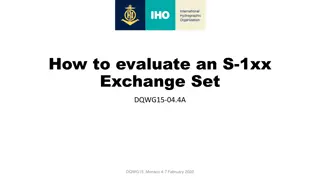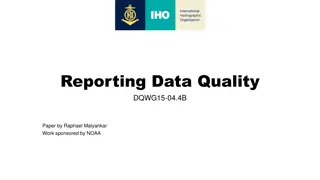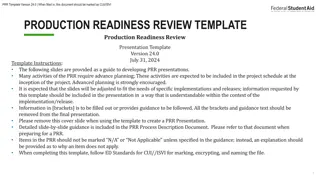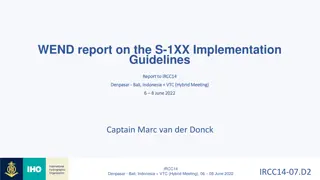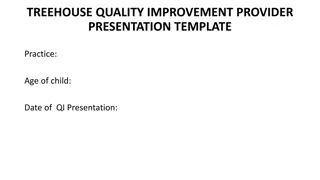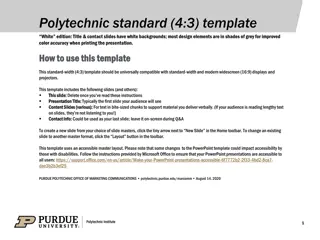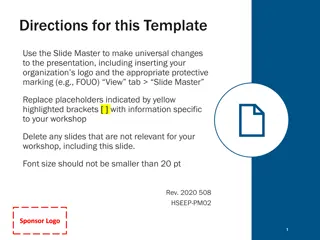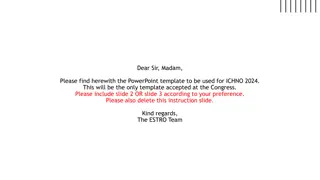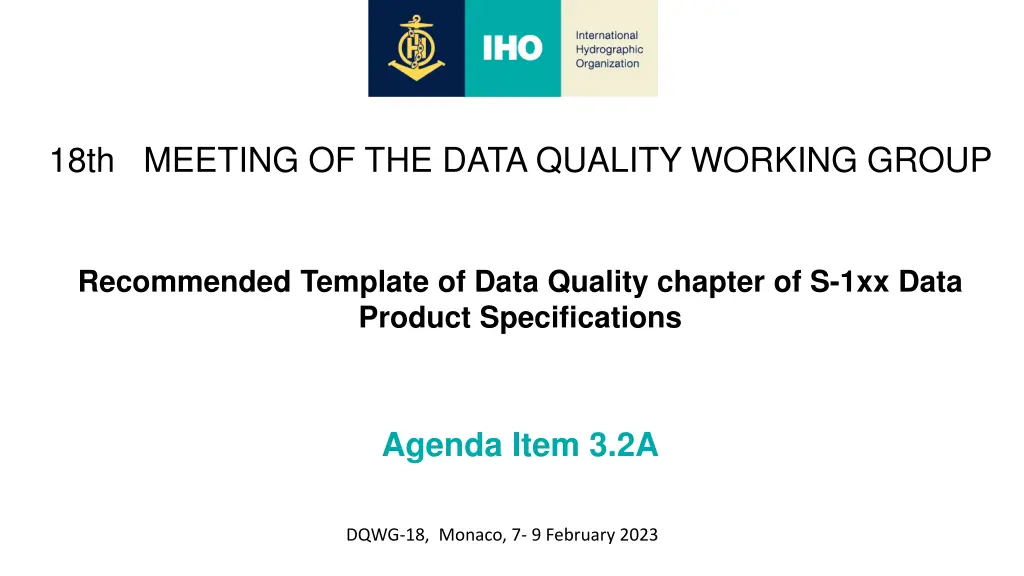
Understanding Data Quality Measures
Discover the importance of data quality in assessing data fitness for various applications. Learn about key data quality elements such as completeness, consistency, accuracy, and more that are essential for evaluating data products. Explore the concept of Commission and Omission checks to ensure the quality of data prior to release. Enhance your knowledge on improving data interoperability and usefulness through reported metadata.
Download Presentation

Please find below an Image/Link to download the presentation.
The content on the website is provided AS IS for your information and personal use only. It may not be sold, licensed, or shared on other websites without obtaining consent from the author. If you encounter any issues during the download, it is possible that the publisher has removed the file from their server.
You are allowed to download the files provided on this website for personal or commercial use, subject to the condition that they are used lawfully. All files are the property of their respective owners.
The content on the website is provided AS IS for your information and personal use only. It may not be sold, licensed, or shared on other websites without obtaining consent from the author.
E N D
Presentation Transcript
18th MEETING OF THE DATA QUALITY WORKING GROUP Recommended Template of Data Quality chapter of S-1xx Data Product Specifications Agenda Item 3.2A DQWG-18, Monaco, 7- 9 February 2023
X.1 INTRODUCTION TO DATA QUALITY INTRODUCTION TO DATA QUALITY Data quality allows users and user systems to assess fitness for use of the provided data. Data quality measures and the associated evaluation are reported as metadata of a data product. This metadata improves interoperability with other data products and provides usage by user groups that the data product was not originally intended for. The secondary users can make assessments of the data product usefulness in their application based on the reported data quality measures. For <this Product Specification> the following Data Quality Elements have been included: - Conformance to this Product Specification; - Intended purpose of the data product; - Completeness of the data product in terms of coverage; - Logical Consistency; - Positional Uncertainty and Accuracy; - Thematic Accuracy; - Temporal Quality; - Aggregation measures; - Validation checks or conformance checks including: General tests for dataset integrity; Specific tests for a specific data model.
X.2 COMPLETENESS X.2 COMPLETENESS X.2.1 Commission Commission is applicable for <this Product Specification> or the data quality scope<XXX> of <this Product Specification>. <This Product Specification> products must be tested with Commission checks prior to release by the data producer. The data producer must review the check results and address any issues to ensure sufficient quality of the data products. The checks are listed in Annex X. [Option a1:] Data should only be published if it passes the test. [Or Option a2:] it is allowable to publish the data with a quality statement which indicates non-conformance. [Option b1:] The product specification shall describe how Commission is to be populated, for example, stating the mechanism to reference the quality evaluation procedure, and allowable values for the quality results. Or [Or Option b2:] In term of Commission, <This Product Specification> products shall at least populate numberOfExcessItems that indicates the number of items that should not have been present in the dataset, and numberOfDuplicateFeatureInstances that indicates the total number of exact duplications of feature instances within the data. Source: S-100 Part 4c Metadata - Data Quality
X.2 COMPLETENESS X.2 COMPLETENESS X.2.2 Omission Omission is applicable for <this Product Specification> or the data quality scope<XXX> of <this Product Specification>. <This Product Specification> products must be tested with Omission checks prior to release by the data producer. The data producer must review the check results and address any issues to ensure sufficient quality of the data products. The checks are listed in Annex X. [Option a1:] Data should only be published if it passes the test. [Or Option a2:] it is allowable to publish the data with a quality statement which indicates non-conformance. [Option b1:] The product specification shall describe how Omission is to be populated, for example, stating the mechanism to reference the quality evaluation procedure, and allowable values for the quality results. [Or Option b2:] In term of Omission, <This Product Specification> products shall at least populate numberOfMissingItems that is the total number of missing items. Source: S-100 Part 4c Metadata - Data Quality
Source: S-100 Part 4c Metadata - Data Quality X.3 X.3 LOGICAL CONSISTENCY LOGICAL CONSISTENCY X.3.1 Conceptual Consistency [Option1:]Conceptual Consistency isn t applicable for <this Product Specification>. [Or Option2:]Conceptual Consistency is applicable for <this Product Specification> or the data quality scope<XXX> of <this Product Specification>and follows the guidelines from S-100 Part 1. <This Product Specification> products must be tested with Conceptual Consistency checks prior to release by the data producer. The data producer must review the check results and address any issues to ensure sufficient quality of the data products. The checks are listed in Annex X. [Option 2a.1:] Data should only be published if it passes the test. [Or Option 2a.2:] it is allowable to publish the data with a quality statement which indicates non- conformance. [Option 2b.1:] The product specification shall describe how Conceptual Consistency is to be populated, for example, stating the mechanism to reference the quality evaluation procedure, and allowable values for the quality results. [Or Option 2b.2:] In term of Conceptual Consistency, <This Product Specification> products shall at least populate numberOfInvalidSurfaceOverlaps that is the total number of erroneous overlaps within the data.
X.3 X.3 LOGICAL CONSISTENCY LOGICAL CONSISTENCY X.3.2 Domain Consistency Domain Consistency is applicable for <this Product Specification> or the data quality scope<XXX> of <this Product Specification>and follows the guidelines from S-100 Part 5. <This Product Specification> products must be tested with Domain Consistency checks prior to release by the data producer. The data producer must review the check results and address any issues to ensure sufficient quality of the data products. The checks are listed in Annex X. [Option a1:] Data should only be published if it passes the test. [Or Option a2:] it is allowable to publish the data with a quality statement which indicates non- conformance. [Option b1:] The product specification shall describe how Domain Consistency is to be populated, for example, stating the mechanism to reference the quality evaluation procedure, and allowable values for the quality results. [Or Option b2:] In term of Domain Consistency, <This Product Specification> products shall at least populate numberOfNonconformantItems that is a count of all items in the dataset that are not in conformance with their value domain. Source: S-100 Part 4c Metadata - Data Quality
X.3 X.3 LOGICAL CONSISTENCY LOGICAL CONSISTENCY X.3.3 Format Consistency Format Consistency is applicable for <this Product Specification> or the data quality scope<XXX> of <this Product Specification>and follows the guidelines from S- 100 Part 10a/10b/10c. <This Product Specification> products must be tested with Format Consistency checks prior to release by the data producer. The data producer must review the check results and address any issues to ensure sufficient quality of the data products. The checks are listed in Annex X. [Option a1:] Data should only be published if it passes the test. [Or Option a2:] it is allowable to publish the data with a quality statement which indicates non-conformance. [Option b1:] The product specification shall describe how Format Consistency is to be populated, for example, stating the mechanism to reference the quality evaluation procedure, and allowable values for the quality results. [Or Option b2:] In term of Format Consistency, <This Product Specification> products shall at least populate physicalStructureConflictsNumber that is a count of all items in the dataset that are stored in conflict with the physical structure of the dataset. Source: S-100 Part 4c Metadata - Data Quality
X.3 X.3 LOGICAL CONSISTENCY LOGICAL CONSISTENCY X.3.4 Topological Consistency [Option1:]Topological Consistency isn t applicable for <this Product Specification>. [Or Option2:]Topological Consistency is applicable for <this Product Specification> or the data quality scope<XXX> of <this Product Specification>and follows the guidelines from S-100 Part 7. <This Product Specification> products must be tested with Topological Consistency checks prior to release by the data producer. The data producer must review the check results and address any issues to ensure sufficient quality of the data products. The checks are listed in Annex X. [Option 2a.1:] Data should only be published if it passes the test. [Or Option 2a.2:] it is allowable to publish the data with a quality statement which indicates non- conformance. [Option 2b.1:] The product specification shall describe how Topological Consistency is to be populated, for example, stating the mechanism to reference the quality evaluation procedure, and allowable values for the quality results. [Or Option 2b.2:] In term of Topological Consistency, <This Product Specification> products shall at least populate rateOfFaultyPoint CurveConnections that is the number of faulty link-node connections in relation to the number of supposed link-node connections, numberOfMissingConnectionsUndershoots that is a count of items in the dataset within the parameter tolerance that are mismatched due to undershoots, numberOfMissing ConnectionsOvershoots that is a count of items in the dataset within the parameter tolerance that are mismatched due to overshoots, numberOfInvalidSlivers that is a count of all items in the dataset that are invalid sliver surfaces, numberOfInvalidSelfIntersects that is a count of all items in the dataset that illegally intersect with themselves, and numberOfInvalidSelfOverlap that is all items in the dataset that illegally self-overlap.
X.3 LOGICAL CONSISTENCY X.3 LOGICAL CONSISTENCY Source: S-100 Part 4c Metadata - Data Quality
X.4 POSITIONAL UNCERTAINTY AND ACCURACY X.4 POSITIONAL UNCERTAINTY AND ACCURACY X.4.1 Absolute or External Accuracy [Option1:] Absolute or External Accuracy isn t applicable for <this Product Specification>. [Or Option2:] Absolute or External Accuracy is applicable for <this Product Specification> or the data quality scope<XXX> of <this Product Specification>and follows the guidelines from S-100 Part 4c. <This Product Specification> products must be tested with Absolute or External Accuracy checks prior to release by the data producer. The data producer must review the check results and address any issues to ensure sufficient quality of the data products. The checks are listed in Annex X. [Option 2a. 1:] Data should only be published if it passes the test. [Or Option 2a.2:] it is allowable to publish the data with a quality statement which indicates non- conformance. [Option 2b.1:] The product specification shall describe how Absolute or External Accuracy is to be populated, for example, stating the mechanism to reference the quality evaluation procedure, and allowable values for the quality results. [Or Option 2b.2:] In term of Absolute or External Accuracy, <This Product Specification> products shall at least populate RMSError that indicates the standard deviation, where the true value is not estimated from the observations but known a priori. Recommendations for Absolute or External Accuracy are as follow: Maximum RMSE (horizontal) = E / 10000 Maximum RMSE (vertical) = Vint / 6 Where: E = Denominator of intended scale of mapping Vint = Normal contour line interval
X.4 POSITIONAL UNCERTAINTY AND ACCURACY X.4 POSITIONAL UNCERTAINTY AND ACCURACY X.4.2 Vertical Position Accuracy [Option1:]Vertical Position Accuracy isn t applicable for <this Product Specification>. [Or Option2:]Vertical Position Accuracy is applicable for <this Product Specification> or the data quality scope<XXX> of <this Product Specification>and follows the guidelines from S-100 Part 4c. <This Product Specification> products must be tested with Vertical Position Accuracy checks prior to release by the data producer. The data producer must review the check results and address any issues to ensure sufficient quality of the data products. The checks are listed in Annex X. [Option 2a.1:] Data should only be published if it passes the test. [Or Option 2a.2:] it is allowable to publish the data with a quality statement which indicates non-conformance. [Option 2b.1:] The product specification shall describe how Vertical Position Accuracy is to be populated, for example, stating the mechanism to reference the quality evaluation procedure, and allowable values for the quality results. [Or Option 2b.2:] In term of Vertical Position Accuracy, <This Product Specification> products shall at least populate linearMapAccuracy3Sigma that indicates the attribute value of uncertainty where half the length of the interval defined by an upper and lower limit in which the true value lies with a probability of 95%.
X.4 POSITIONAL UNCERTAINTY AND ACCURACY X.4 POSITIONAL UNCERTAINTY AND ACCURACY X.4.3 Horizontal Position Accuracy [Option1:]Horizontal Position Accuracy isn t applicable for <this Product Specification>. [Or Option2:]Horizontal Position Accuracy is applicable for <this Product Specification> or the data quality scope<XXX> of <this Product Specification>and follows the guidelines from S-100 Part 4c. <This Product Specification> products must be tested with Horizontal Position Accuracy checks prior to release by the data producer. The data producer must review the check results and address any issues to ensure sufficient quality of the data products. The checks are listed in Annex X. [Option 2a.1:] Data should only be published if it passes the test. [Or Option 2a.2:] it is allowable to publish the data with a quality statement which indicates non-conformance. [Option 2b.1:] The product specification shall describe how Horizontal Position Accuracy is to be populated, for example, stating the mechanism to reference the quality evaluation procedure, and allowable values for the quality results. [Or Option 2b.2:] In term of Horizontal Position Accuracy, <This Product Specification> products shall at least populate circularError95 that indicates the radius describing a circle in which the true point location lies with the probability of 95%.
X.4 POSITIONAL UNCERTAINTY AND ACCURACY X.4 POSITIONAL UNCERTAINTY AND ACCURACY Source: S-100 Part 4c Metadata - Data Quality
X.4 POSITIONAL UNCERTAINTY AND ACCURACY X.4 POSITIONAL UNCERTAINTY AND ACCURACY Source: S-100 Part 4c Metadata - Data Quality
X.4 POSITIONAL UNCERTAINTY AND ACCURACY X.4 POSITIONAL UNCERTAINTY AND ACCURACY X.4.4 Relative or Internal Accuracy [Option1:]Relative or Internal Accuracy isn t applicable for <this Product Specification>. [Option2:]Relative or Internal Accuracy is applicable for <this Product Specification> or the data quality scope of <this Product Specification>and follow the guidelines from S-100 Part 4c. <This Product Specification> products must be tested with Relative or Internal Accuracy checks prior to release by the data producer. The data producer must review the check results and address any issues to ensure sufficient quality of the data products. The checks are listed in Annex X. [Option 2a. 1:] Data should only be published if it passes a particular test. [Or Option 2a.2:] it is allowable to publish the data with a quality statement which indicates non-conformance. [Option 2b.1:] The product specification shall describe how Relative or Internal Accuracy is to be populated, for example, stating the mechanism to reference the quality evaluation procedure, and allowable values for the quality results. [Or Option 2b.2:] In term of Relative or Internal Accuracy, <This Product Specification> products shall populate one or both of the relativeVerticalError that indicates an evaluation of the random errors of one relief feature to another in the same data set or on the same map/chart, and relativeHorizontalError that indicates an evaluation of the random errors in the horizontal position of one feature to another in the same data set or on the same map/chart.
X.4 POSITIONAL UNCERTAINTY AND ACCURACY X.4 POSITIONAL UNCERTAINTY AND ACCURACY Source: S-100 Part 4c Metadata - Data Quality
X.4 POSITIONAL UNCERTAINTY AND ACCURACY X.4 POSITIONAL UNCERTAINTY AND ACCURACY X.4.5 Gridded Data Positional Accuracy [Option1:]Gridded Data Position Accuracy isn t applicable for <this Product Specification>. [Or Option2:]Gridded Data Position Accuracy is applicable for <this Product Specification> or the data quality scope<XXX> of <this Product Specification>and follows the guidelines from S-100 Part 4c. <This Product Specification> products must be tested with Gridded Data Position Accuracy checks prior to release by the data producer. The data producer must review the check results and address any issues to ensure sufficient quality of the data products. The checks are listed in Annex X. [Option 2a.1:] Data should only be published if it passes the test. [Or Option 2a.2:] it is allowable to publish the data with a quality statement which indicates non-conformance. Gridded positional accuracy is defined by the precision of the positional reference used to specify its location within its spatial projection. These positional references are contained within the spatial metadata of the <this Product Specification> grid. Nodes within a grid have an absolute position with no horizontal error with vertical values that are calculated for that position by the processes and procedures used by each data producer during the creation of the <this Product Specification> grid. Appropriate selection of both the origin reference points and positional resolution are important and are another factor in gridded positional accuracy. In term of Gridded Data Position Accuracy, <This Product Specification> products shall at least populate RMSErrorPlanimetry that indicates the radius of a circle around the given point, in which the true value lies with probability P. Recommendations for Gridded Data Position Accuracy are as follow: Maximum RMSE (horizontal) = GSD / 6 Maximum RMSE (vertical) = GSD / 3 Where: GSD = Ground Sampling Distance
X.4 POSITIONAL UNCERTAINTY AND ACCURACY X.4 POSITIONAL UNCERTAINTY AND ACCURACY Source: S-100 Part 4c Metadata - Data Quality
X.5 THEMATIC ACCURACY X.5 THEMATIC ACCURACY X.5.1 Thematic Classification Correctness Thematic Classification Correctness is applicable for <this Product Specification> or the data quality scope<XXX> of <this Product Specification>and follows the guidelines from S-100 Part 4c. <This Product Specification> products must be tested with Thematic Classification Correctness checks prior to release by the data producer. The data producer must review the check results and address any issues to ensure sufficient quality of the data products. The checks are listed in Annex X. [Option a1:] Data should only be published if it passes the test. [Or Option a2:] it is allowable to publish the data with a quality statement which indicates non-conformance. [Option b1:]The product specification shall describe how Thematic Classification Correctness is to be populated, for example, stating the mechanism to reference the quality evaluation procedure, and allowable values for the quality results. [Or Option b2:] In term of Thematic Classification Correctness, <This Product Specification> products shall at least populate miscalculationRate that is the number of incorrectly classified features in relation to the number of features that are supposed to be there. Source: S-100 Part 4c Metadata - Data Quality
X.5 THEMATIC ACCURACY X.5 THEMATIC ACCURACY X.5.2 Non-Quantitative Attribute Accuracy [Option1:]Non-Quantitative Attribute Accuracy isn t applicable for <this Product Specification>.Thematic accuracy of <this Product Specification> data is wholly quantitative. [Or Option2:]Non-Quantitative Attribute Accuracy is applicable for <this Product Specification> or the data quality scope<XXX> of <this Product Specification>and follows the guidelines from S-100 Part 4c. <This Product Specification> products must be tested with Non- Quantitative Attribute Accuracy checks prior to release by the data producer. The data producer must review the check results and address any issues to ensure sufficient quality of the data products. The checks are listed in Annex X. [Option 2a.1:] Data should only be published if it passes the test. [Or Option 2a.2:] it is allowable to publish the data with a quality statement which indicates non- conformance. [Option 2b.1:] The product specification shall describe how Non- Quantitative Attribute Accuracy is to be populated, for example, stating the mechanism to reference the quality evaluation procedure, and allowable values for the quality results. [Or Option 2b.2:] The accuracy of non-quantitative attributes can be correct or incorrect. <This Product Specification> products shall at least populate numberOfIncorrectAttributeValues that is a count of all attribute values where the value is incorrect. Source: S-100 Part 4c Metadata - Data Quality
X.5 THEMATIC ACCURACY X.5 THEMATIC ACCURACY X.5.3 Quantitative Attribute Accuracy [Option1:]Quantitative Attribute Accuracy isn t applicable for <this Product Specification>.Thematic accuracy of <this Product Specification> data is wholly non-quantitative. [Or Option2:]Quantitative Attribute Accuracy is applicable for <this Product Specification> or the data quality scope<XXX> of <this Product Specification>and follows the guidelines from S-100 Part 4c. <This Product Specification> products must be tested with Quantitative Attribute Accuracy checks prior to release by the data producer. The data producer must review the check results and address any issues to ensure sufficient quality of the data products. The checks are listed in Annex X. [Option 2a.1:] Data should only be published if it passes the test. [Or Option 2a.2:] it is allowable to publish the data with a quality statement which indicates non-conformance. [Option 2b.1:] The product specification shall describe how Quantitative Attribute Accuracy is to be populated, for example, stating the mechanism to reference the quality evaluation procedure, and allowable values for the quality results. [Or Option 2b.2:] The accuracy of quantitative attributes can be measured in terms of uncertainty intervals. <This Product Specification> products shall at least populate attributeValueUncertainty3Sigma that indicates the attribute value of uncertainty where half the length of the interval defined by an upper and lower limit in which the true value for the quantitative attribute lies with a probability of 95%. Source: S-100 Part 4c Metadata - Data Quality
X.6 TEMPORAL QUALITY X.6 TEMPORAL QUALITY X.6.1 Temporal Consistency [Option1:]Temporal Consistency isn t applicable for <this Product Specification>. [Or Option2:]Temporal Consistency is applicable for <this Product Specification> or the data quality scope<XXX> of <this Product Specification>and follows the guidelines from S-100 Part 4c. <This Product Specification> products must be tested with Temporal Consistency checks prior to release by the data producer. The data producer must review the check results and address any issues to ensure sufficient quality of the data products. The checks are listed in Annex X. [Option 2a.1:] Data should only be published if it passes the test. [Or Option 2a.2:] it is allowable to publish the data with a quality statement which indicates non-conformance. In term of Temporal Consistency, <This Product Specification> products shall populate chronologicalOrder that indicate that an event is incorrectly ordered against the other events. Source: S-100 Part 4c Metadata - Data Quality
X.6 TEMPORAL QUALITY X.6 TEMPORAL QUALITY X.6.2 Temporal Validity [Option1:]Temporal Validity isn t applicable for <this Product Specification>. [Or Option2:]Temporal Validity is applicable for <this Product Specification> or the data quality scope<XXX> of <this Product Specification>and follows the guidelines from S-100 Part 4c. <This Product Specification> products must be tested with Temporal Validity checks prior to release by the data producer. The data producer must review the check results and address any issues to ensure sufficient quality of the data products. The checks are listed in Annex X. [Option 2a.1:] Data should only be published if it passes the test. [Or Option 2a.2:] it is allowable to publish the data with a quality statement which indicates non-conformance. [Option 2b.1:]The product specification shall describe how Temporal Validity is to be populated, for example, stating the mechanism to reference the quality evaluation procedure, and allowable values for the quality results. [Or Option 2b.2:] In term of Temporal Validity, <This Product Specification> products shall at least populate numberOfNonConformantItems that is a count of all items in the dataset that are not in conformance with their value domain.
X.6 TEMPORAL QUALITY X.6 TEMPORAL QUALITY Source: S-100 Part 4c Metadata - Data Quality
X.6 TEMPORAL QUALITY X.6 TEMPORAL QUALITY X.6.3 Temporal Accuracy [Option1:]Temporal Accuracy isn t applicable for <this Product Specification>. [Or Option2:]Temporal Accuracy is applicable for <this Product Specification> or the data quality scope<XXX> of <this Product Specification>and follows the guidelines from S-100 Part 4c. <This Product Specification> products must be tested with Temporal Accuracy checks prior to release by the data producer. The data producer must review the check results and address any issues to ensure sufficient quality of the data products. The checks are listed in Annex X. [Option 2a.1:] Data should only be published if it passes the test. [Option 2a.2:] it is allowable to publish the data with a quality statement which indicates non-conformance. [Option 2b.1:] The product specification shall describe how Temporal Accuracy is to be populated, for example, stating the mechanism to reference the quality evaluation procedure, and allowable values for the quality results. [Or Option 2b.2:] In term of Temporal Accuracy, <This Product Specification> products shall at least populate attributeValueUncertainty3Sigma that indicates the attribute value of uncertainty where half the length of the interval defined by an upper and lower limit in which the true value for the quantitative attribute lies with a probability of 95%.
X.6 TEMPORAL QUALITY X.6 TEMPORAL QUALITY Source: S-100 Part 4c Metadata - Data Quality
X.7 AGGREGATION X.7 AGGREGATION [Option1:]Aggregation isn t applicable for <this Product Specification>. [Or Option2:]Aggregation is applicable for <this Product Specification> or the data quality scope<XXX> of <this Product Specification>. The aggregated Data Quality result provides a result if the dataset has passed conformance to the Data Product Specification. <This Product Specification> products must be tested with Aggregation checks prior to release by the data producer. The data producer must review the check results and address any issues to ensure sufficient quality of the data products. The checks are listed in Annex X. [Option 2a.1:] Data should only be published if it passes the test. [Or Option 2a.2:] it is allowable to publish the data with a quality statement which indicates non-conformance. <This Product Specification> product shall include a standalone quality report which provides full information on the original results (with evaluation procedures and measures applied), the aggregated result, and the aggregation method. The dataset or exchange set metadata that is distributed with the exchange set will describe only the aggregated result with a reference to the original results described in the standalone quality report. [Option 2b.1:]The product specification shall describe how Aggregation is to be populated, for example, stating the mechanism to reference the quality evaluation procedure, and allowable values for the quality results. [Or Option 2b.2:] In term of Aggregation, <This Product Specification> products shall at least populate DataProductSpecificationPassed that is a Boolean indicating that all requirements in the referred data product specification are fulfilled, and DataProductSpecificationFailRate that is a number indicating the number of data product specification requirements that are not fulfilled by the current product/dataset in relation to the total number of data product specification requirements.
X.7 AGGREGATION X.7 AGGREGATION Source: S-100 Part 4c Metadata - Data Quality
X.8 QUALITY MEASURE ELEMENTS X.8 QUALITY MEASURE ELEMENTS
X.8 QUALITY MEASURE ELEMENTS X.8 QUALITY MEASURE ELEMENTS
X.8 QUALITY MEASURE ELEMENTS X.8 QUALITY MEASURE ELEMENTS
X.8 QUALITY MEASURE ELEMENTS X.8 QUALITY MEASURE ELEMENTS
ACTION REQUIRED OF DQWG The DQWG is invited to: a. Note the information provided; b. Endorse the recommended template and submit it to HSSC 15 for approval.







